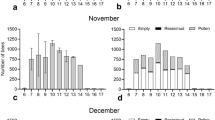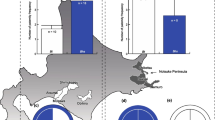Abstract
The visitation pattern by worker honey bees to cells in the brood nest was monitored on an artificially created brood pattern consisting of about one-fourth brood cells evenly distributed among empty cells. The majority (63 %) of the observed workers selectively entered larval cells. In contrast, some workers avoided egg cells when presented a choice of egg vs empty cells. The results suggest that larvae produce a general signal indicating their presence to worker bees. Eggs also seem to produce a signal, which is perceived to be different from the one from larvae.
Similar content being viewed by others
References
Beetsma, J. (1985). Feeding behavior of nurse bees, larval food composition and caste differentiation in the honey bee(Apis mellifera L.). In Hölldobler, B., and Lindauer, M. (eds.),Experimental Behavioral Ecology and Sociobiology, Sinauer Associates, Sunderland, Mass., pp. 407–410.
Brouwers, E. V. M. (1984). Glucose/fructose ratio in the food of honeybee larvae during caste differentiation.J. Apic. Res. 23: 94–101.
Brouwers, E. V. M., Eben, R., and Beetsma, J. (1987). Behaviourial and physiological aspects of nurse bees in relation to the composition of larval food during caste differentiation in the honeybee.J. Apic. Res. 26: 11–17.
Free, J. B. (1987).Pheromones of Social Bees, Comstock, New York.
Free, J. B., and Winder, M. E. (1983). Brood recognition by honeybee(Apis mellifera) workers.Anim. Behav. 31: 539–545.
Gontarski, H. (1954). Untersuchungen über die Verwertung von Pollen und Hefe zur Brutpflege der Honigbiene.Z. Bienenforsch. 2: 161–180.
Huang, Z.-Y. (1988).Mechanism of Hypopharyngeal Gland Activation by Brood of Honey Bees (Apis mellifera L.), Ph.D. dissertation, University of Guelph, Ontario, Canada.
Huang, Z.-Y., and Otis, G. W. (1990). Inspection and feeding of larvae by worker honey bees: Effect of starvation and food quantity.J. Insect Behav. (in press).
Jung-Hoffmann, I. (1966). Die Determination von Königin und Arbeiterin der Honigbiene.Z. Bienenforsch. 8: 296–322.
Koeniger, N., and Veith, H. J. (1983). Glyceryl-1,2-dioleate-3-palmitate as a brood pheromone of the honey bee(Apis mellifera L.).Experientia 39: 1051–1052.
Kolmes, S. A. (1985). A quantitative study of the division of labour among worker honey bees.Z. Tierpsychol. 68: 287–302.
Le Conte, Y., Arnold, G., Trouiller, J., Masson, C., Chapper, B., and Ourisson, G. (1989). Attraction of the parasitic miteVarroa to the drone larvae of honey bees by simple aliphatic esters.Science 245: 638–639.
Lindauer, M. (1953). Division of labour in the honeybee colony.Bee World 34: 63–73, 85–91.
Lineburg, B. (1924). The feeding of honeybee larvae.Bull. U.S. Dept. Agr. 1222: 25–37.
Shuel, R. W., and Dixon, S. E. (1959). Studies in the mode of action of royal jelly in honeybee development. II. Respiration of newly emerged larvae on various substrates.Can. J. Zool. 37: 803–813.
Snodgrass, R. E., (1956).Anatomy of the Honey Bee, Comstock, Cornell University Press, Ithaca, N.Y.
Steel, R. G. D., and Tome, J. H. (1980).Principles and Procedures of Statistics, a Biometrical Approach, McGraw-Hill, New York.
Thrasyvoulou, A. T., Collison, C. H., and Benton, A. W. (1983). Electrophoretic patterns of water-soluble proteins of honeybee larval food.J. Apic. Res. 22: 142–145.
Author information
Authors and Affiliations
Rights and permissions
About this article
Cite this article
Huang, ZY., Otis, G.W. Nonrandom visitation of brood cells by worker honey bees (Hymenoptera: Apidae). J Insect Behav 4, 177–184 (1991). https://doi.org/10.1007/BF01054610
Accepted:
Issue Date:
DOI: https://doi.org/10.1007/BF01054610




